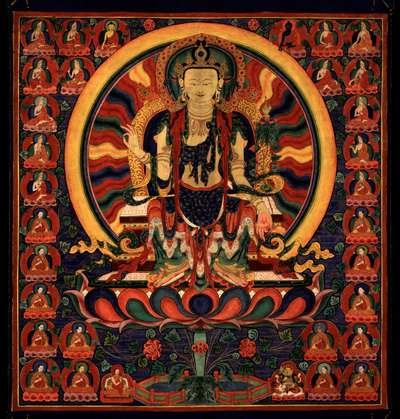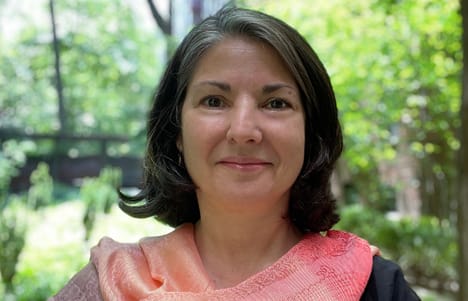
About the Meditation Podcast
Meditation session led by Kimberly Brown.
The guided meditation begins at 13:12.
For centuries Himalayan practitioners have used meditation to quiet the mind, open the heart, calm the nervous system, and increase focus. Now Western scientists, business leaders, and the secular world have embraced meditation as a vital tool for brain health.
Whether you’re a beginner, a dabbler, or a skilled meditator seeking the company of others, join expert teachers in a forty-five-minute weekly program designed to fit into your lunch break. Each session will be inspired by a different work of art from the Rubin Museum’s collection and will include an opening talk, a twenty-minute meditation session, and a closing discussion.
This program is supported in part by the Hemera Foundation with thanks to our presenting partners Sharon Salzberg, the Interdependence Project, and Parabola Magazine.


Related Artwork

Theme: Awakening
This luminous painting of the Future Buddha, Maitreya, shows him sitting on his celestial throne in Tushita heaven radiating light. The Future Buddha sits with his legs extended as if poised and ready to descend to earth and take up his ministry as the buddha of the next eon. He is adorned with the princely jewels and garb of a bodhisattva, having not yet taken up his future role as the next buddha, when he would be depicted in monk’s robes like the buddha of our current age, Shakyamuni. In his left hand Maitreya holds the stem of a Nagakesara blossom that carries a flask, his distinctive identifying attribute.
His throne is supported by a lotus emerging from a fenced pond, the branches of which form the subtle scroll that frames all of the secondary figures. The extensive teaching lineage it contains at the sides indicates that this painting refers to the Five Treatises of Maitreya, five commentaries on Buddha Shakyamuni’s teachings attributed to Maitreya.
Exemplary for fifteenth-century art, this painting continues organizational features from earlier styles but places the figures against a uniform dark-blue sky background with stylized clouds. Typical for the period are the large leaves and flowers branching off the scrolling lotus throughout the painting. Thus, although there is no landscape as such, the composition does create a sense of space around the figures that is absent in earlier paintings. Compared with the nearly contemporaneous Gyantse murals, the decorations here are restrained and exemplify the stylistic possibilities shortly before the landscape revolution of the mid-fifteenth century.
About the Speaker

Kimberly Brown is a meditation teacher and author. She leads classes and retreats that emphasize the power of compassion and kindness meditation to reconnect us to ourselves and others. Her teachings provide an approachable pathway to personal and collective well-being through effective and modern techniques based on traditional practices. She studies in both the Tibetan and Insight schools of Buddhism and is a certified mindfulness instructor. Her new book, Navigating Grief And Loss: 25 Buddhist Practices to Keep Your Heart Open to Yourself and Others, will be published in November, and an updated edition of Steady, Calm, and Brave will be released in January 2023. Both are published by Prometheus Books. You can learn more about Kimberly on her website.
